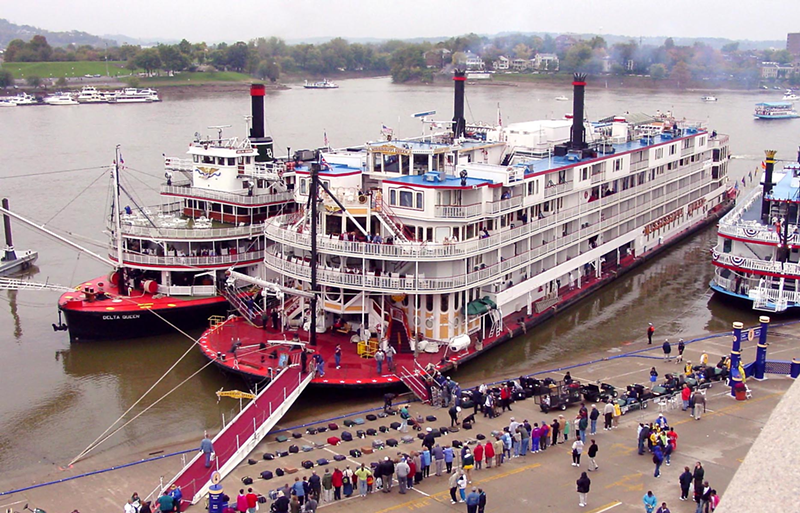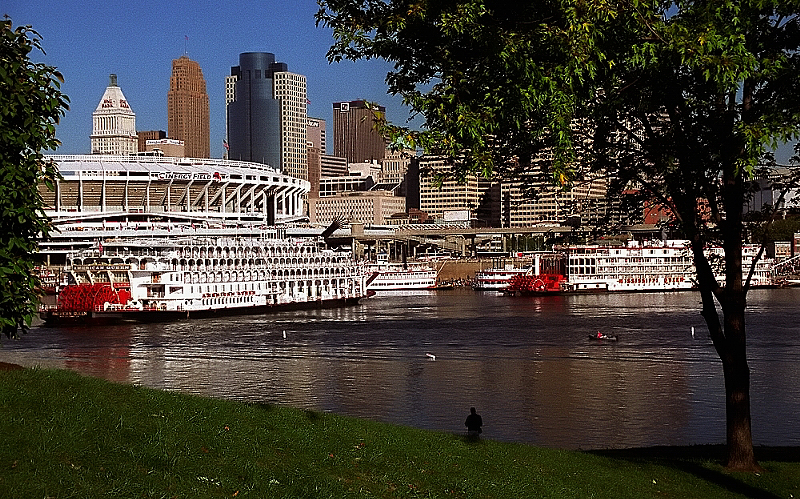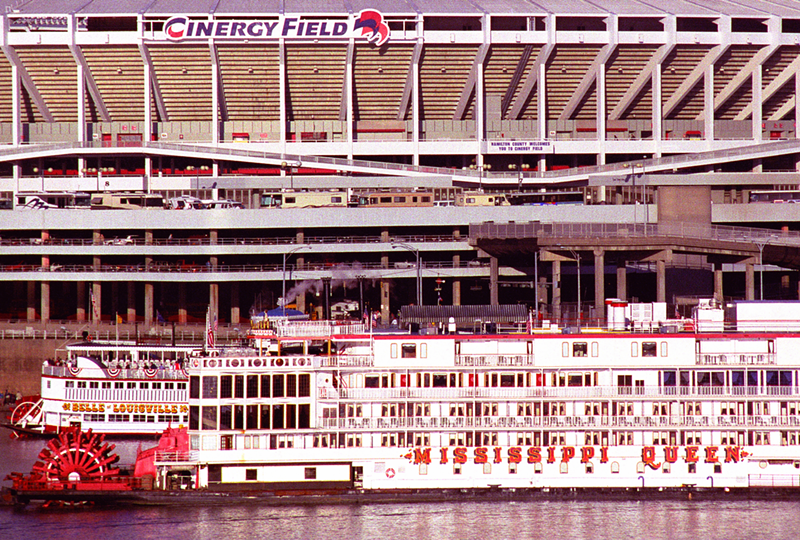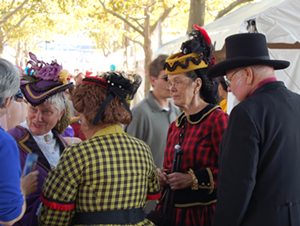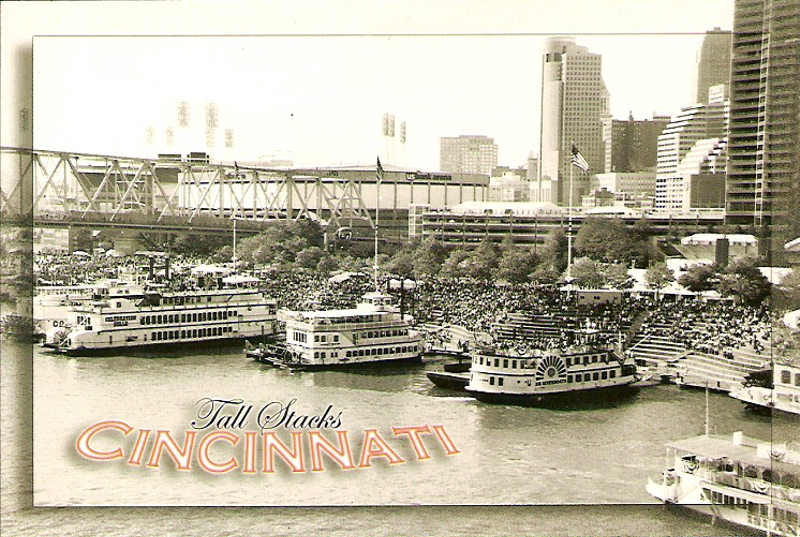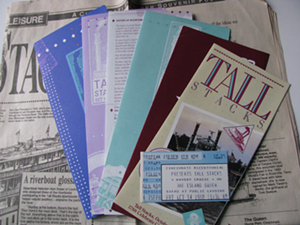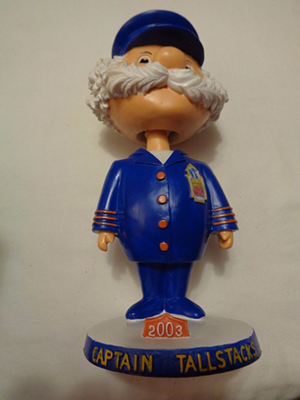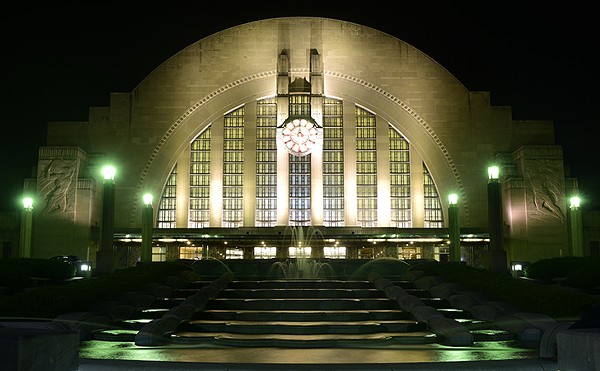So, whatever happened to Tall Stacks?
You likely remember this grand triennial gathering of steamboats on the city’s Public Landing, first born 30 years ago this week, in October 1988. A gorgeous observance, the festival — initially hosted as part of Cincinnati’s bicentennial — eventually evolved over two decades into the world’s largest convocation of sternwheeler riverboats, as well as a standout tribute to Roots music, Midwestern heritage and all things Americana. The confab bridged a sweeping arc of river legacy, a narrative and timeline attempting to connect two centuries of life along the Ohio River.
Then, poof, suddenly the showpiece event vanished after 2006, sinking into fleeting memory. So why did this city’s watershed calling card, our own nifty nautical and cascading musical wonder, wind up cruising into the dustbin of neglected castaways?
On this 30th anniversary to mark the christening of that first iconic riverboat festival, we now pause to reconsider and reflect on how it is, exactly, that the Queen City could have possibly lost its signature celebration.
The Beginning
If you weren’t living in Cincinnati for any of the six incarnations of the recurring Tall Stacks, here’s your Cliff Notes background primer: Paddle-wheelers have always come with a historic pedigree in the Port of Cincinnati.
A giant paddle wheel sits at the Public Landing along the Ohio riverfront near Great American Ball Park as a monument to the steamboat legacy of the Queen City. The revolutionary method of river travel emerged in the early 19th century as a way to transport products (and people) more easily and quickly across the region, with Cincinnati joining Wheeling, West Virginia and Pittsburgh as the capitol cities of the industry built around the Ohio River. After the Civil War, railroads and barges gradually did away with steamboats and they mostly became tourist attractions that carried passengers on short trips.
One-time Cincinnatian Mark Twain loved our riverboats. Charles Dickens — after taking a steamboat voyage from Pittsburgh to Cincinnati in 1842 — abhorred them for their tendency to explode. Whatever camp you happen to fall in, one thing’s for certain: For nearly 20 years, there was no escaping this festival of riverboats on the city’s waterfront every third year or so. The flagship event surged into a total of six splashy appearances: After 1988, it returned in 1992, 1995, 1999, 2003 and 2006.
As a particularly unique assembly of up to two dozen vintage paddle-wheelers, the Tall Stacks festival soon became a world-class regatta which regularly packed the Ohio riverfront with nearly one million gawkers from across the country and from across the world.
In those first heady days, well-heeled guests might plunk down $1,010 per night for an overnight steamboat voyage down river (if you wanted steerage class, you could buy a moderately-priced passport for $22 and up). But all could relish the harbor jaunts, costumed re-enactments and pilothouse tours back-dropped by the melody of calliope pipes, an unlikely cross between an organ and a fire siren.
“We knew we were witnessing the end of (the riverboat era) and so the Tall Stacks events were especially exciting,” recalls retired Cincinnati Enquirer cultural critic Owen Findsen, who covered the 1988 Tall Stacks premiere for the paper. “They were thrilling celebrations that were distinctly appropriate for this river city.”
Bon Voyage
By any yardstick, the first Tall Stacks was an adventure where amazing aspirations met great expectations.
As ambitious Tall Stacks visionaries set their sights early, they modeled this quixotic concept upon the incredibly popular East Coast “Tall Ships” schooner festivals, which came in the form of multi-day regattas and sailboat parades.
Local developer Rick Greiwe, who’d signed on as executive director of the city’s Bicentennial Commission, noted in a 1988 Cincinnati Magazine article, “We could have just had a parade and forgotten about it.” Instead, Greiwe, along with the city fathers and mothers, plunged into embarking on this singular moment of enormous scope, firing the community’s imagination.
“Tall Stacks was an outgrowth of when I was mayor,” says now-Cincinnati-Councilman David Mann, who appointed the Bicentennial Committee back in 1982. (Mann comes by his sea legs honestly—he’s a veteran of a four-year tour on a U.S. Navy destroyer.) Back then, Tall Stacks moved from a modest scribble on Mann’s mayoral desk to dominating the region’s own distinctive legacy brand.
“My main memory of Tall Stacks is seeing all those vessels coming into our port. It was an overwhelming enjoyment,” he says.
In 1988, 14 riverboats attracted more than 700,000 visitors for a three-day tour. In 1992, the excursion expanded to four days and more than 800,000 tourists. By 1995, the now five-day event lured 19 riverboats and nearly 850,000 paying guests to the river’s edge.
In 1999, the American Bus Association and AAA named it the No. 1 travel destination in the nation. But that soggy year, rainy weather and river flooding dampened attendance down to a mere 660,000.
By 2006, the event had rebounded somewhat, attracting 800,000 along with 16 riverboats.
All this carnival excitement hearkened back to a gilded age when puffing steamboat transport assured Cincinnati’s role as one of the largest urban centers in the country, aplomb with the lifestyle’s inherent romance and gorgeous garnishes. Supporters point to memorable showboat moments such as the treasured “Parade of Tall Stacks” regatta and the tremendous riverboat races, with participating captains vying to take home the prized “Golden Antlers “ trophy as crowds on the shorelines cheered wildly.
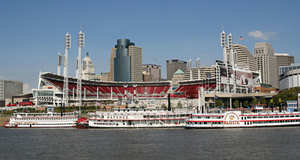
The docked steamboats stretched from the Public Landing and Yeatman’s Cove along Bicentennial Commons to Sawyer (as in Tom Sawyer) Point and the winding Serpentine Wall. Visitors flocked to the riverbanks as if it were 1875 all over again, creating an engaging portrait of a vintage era near lost.
The royal pageant of massive riverboats included the monolithic seven-deck Mississippi Queen, the four-deck General Jackson showboat, the four-deck Delta Queen, the four-deck Belle of Cincinnati, the three-deck Belle of Louisville, the three-deck Majestic, the three-deck Creole Queen, the two-deck Spirit of Cincinnati and the wedding-cake-styled Spirit of Peoria.
A potpourri of smaller boats joined in the fray afloat, including Keystone Belle (built locally by Tucker Marine), Southern Belle, Queen of Hearts, the Natchez and more, like the Tom Sawyer and Becky Thatcher.
Some of these visiting vessels easily spanned the length of a football field or longer, accommodating hundreds of passengers. The Victorian-style Colonial out of Galveston, Texas held record passage for traveling the farthest: 1,700 miles from its home port to here. The Mississippi Queen made its trip from New Orleans, as did the Delta Queen.
“My fondest memory of the Tall Stacks was the moment the Belle of Louisville arrived,” The Enquirer’s Findsen says. “She steered toward the Kentucky shore and turned to come head-on toward the Public Landing. As she started forward, she released the steam valves and disappeared into a white cloud, reemerging full speed with the whistle blowing. It was a moment such as Mark Twain had described.”
Eventually, Tall Stacks segued into a five-day extravaganza, an attraction that blessed both sides of the Ohio River shorelines. In 2003, with a music-festival component added on, it was re-dubbed the “Tall Stacks Music, Arts and Heritage Festival.”
The re-envisioned Tall Stacks boasted an impressive array of national-caliber musical players, amplifying an already high-profile event. On any given day, you could expect to check out Shawn Colvin, Mary Chapin Carpenter, Dar Williams, Emmylou Harris, Lucinda Williams, Wilco, Patty Griffin, Steve Earle, Nickel Creek, The Blind Boys of Alabama, Abigail Washburn, Al Green, Roseanne Cash, Ricky Skaggs, Delbert McClinton, Buddy Guy, Dr. John, Over the Rhine, B.B. King, Bo Diddley, The Del McCoury Band, John Hammond, John Hiatt, Los Lobos, Creedence Clearwater Revisited and many others.
One such performer (as well as a member of the Tall Stacks entertainment booking committee), Katie Laur, shared this recollection in Cincinnati Magazine in 2017: “Riverbanks were transformed into another century, another time. Women dressed in antebellum gowns and strolled from boat to boat while banjos and fiddles played Stephen Foster songs. All of it filled the air like a dream, and for those days, Cincinnatians worshipped the river.”
The Big Sink

Keen observers suggest the Tall Stacks brand succumbed as a victim of its own success.
“My impression is that public interest paled; then there was cost (approximately $10 million for each year) and the difficulty finding corporate sponsors,” Councilman Mann says. “And, convincing river captains to come, leaving their home ports.”
Not the least of it was that Congress essentially killed off the Delta Queen by revoking an exemption that allowed wooden-hulled boats to carry overnight passengers.
“The Delta Queen was a big part of it,” Findsen says. “Why did the Tall Stacks end? Most of the authentic boats were grounded by federal safety regulations, and the excursion boats that replaced them had difficulty adjusting their busy schedules to the event.
“Besides, those party boats are novelty imitations with silly fake paddle-wheels. They are to real steamboats as Dixieland is to New Orleans Jazz.”
In truth, myriad confluences contributed to the festival’s downfall. It was like listening to the long plaintive wail of calliope pipes all disappearing downstream. Here are a few:
Rain: Some years, the skies rained misery on the Tall Stacks parade. Rising flood tides then threatened to cut off access to the Public Landing. Currents became treacherous and disruptive. The river channel sometimes turned into a muddy cesspool of broken branches and pesky debris; uprooted tree trunks plowed into town as virtual weaponized torpedoes. In ensuing years, a spate of furious hurricanes along the Gulf Coast hampered continuous operations for many a steamboat company down South.
During the 2006 finale appearance of Tall Stacks, eight inches of rain fell up river in Pittsburgh, which threatened to shut operations since the river was deemed too swift and dangerous.
Heat: Unpredictable dry spells and forces of nature could conversely depress river levels to a record-low watermark, both here and on the Mississippi River. Senior citizens formed the core demographic of patrons, and subsequently several suffered heat exhaustion or sunstroke.
Security Fees: Not surprisingly, boat security costs and insurance fees soared in the wake of 9/11. The World Trade Center attacks demanded organizers place a new focus on homeland security. Off-duty police patrols added to the stressed Tall Stacks budget. The Cincinnati Coast Guard and FBI finally joined forces to send disposal experts diving in scuba gear to inspect each steamboat hull every hour for possible deep-water explosives.
Likewise, bridges posed a potential target. SWAT teams trained for any threat. Hosting one of the largest crowds to gather in the country — short of the assemblies at the Boston Marathon and the Atlanta Olympics — our city’s fear of homegrown terrorist bombers then consequently mushroomed.
Ships: With the demise of a half-dozen authentic riverboats that had traditionally participated, organizers were forced to turn to “replicas” and paddle-wheeler knock-offs. This served only to dilute the vintage heritage message.
Commerce: All the intense riverboat and pleasure craft activity teamed to stall coal-barge traffic; the all-powerful coal barons were not amused, especially as the festival grew in length to a full five days, which blocked their product from market.
The Great Recession: A Tall Stacks 2009 edition was initially planned, but stock-market chaos preceding the previous year’s economic crash shredded many corporate sponsorships. Tax revenues imploded as taxpayer support waned. Classify it “the steamboat willies.” After 2009, a 2010 incarnation was rescheduled, but was trashed as well. Finally, plans for a 2012 incarnation hit the reefs. That was enough.
A question remains today whether the changing infrastructure along our metro’s waterfront might preclude any possible hope for a Tall Stacks encore, no matter what the economy. The addition of structures such as Great American Ball Park, the Reds Hall of Fame museum, The Banks, the National Underground Railroad Freedom Center, Smale Park, Paul Brown Stadium and other entries now crowd the space and parking options. A conceived 4,000-seat riverside concert hall only multiplies the uncertainties.
A Chance to Reboard?
The Cincinnati Symphony Orchestra’s subsidiary called Music & Event Management Inc. (MEMI) eventually took over the Tall Stacks helm early last decade. But MEMI’s CEO Mike Smith — faced with a tide of gatherings such as its own Jammin’ on Main (which folded in the mid-’00s) and Midpoint Music Festival (now MEMI-owned but on hold this year), plus newer events like The National’s Homecoming festival and the Bunbury Music Festival — told the Business Courier as recently as June that something had to give: “We did the best we could under the circumstances. The people who criticized us … why didn’t they step up? It’s one thing to want to help out the city, but these things have to be financially successful.”
Smith specifically recalls that, in the thick of planning for 2009, MEMI couldn’t pin down major corporate anchors; many had been drowned by the tidal wave of the Great Recession and its aftermath.
"The flooding took out a morning" one year, Smith told CityBeat. "Then the economy crashed in 2008 and 2009. And (out-of-town) river captains were then reluctant to commit," he says.
Soon to follow, adding to the casualty toll: The passing of traditional civic under-writers such as the late Carl Lindner.
Yet another consequence forced by the passage of time: Companies such as former mainstay Chiquita had chosen to abandon the city, relocating their company headquarters to more faraway states. Given all this, the key players opted to throw Tall Stacks overboard instead of rearranging the format. In the end, there wasn’t even enough meager enthusiasm to keep the “TallStacks.org” website afloat.
By the beginning of the 2010s, Smith busily set underway focusing on other endeavors such as Lumenocity (also since shuttered), and more recently MEMI was granted the contract for the aforementioned new riverfront concert venue. The nonprofit 3CDC, in the meantime, was luring potential music lovers to the revamped Washington Park area in Over-the-Rhine.
And there was this looming specter walking the gangplank, the Grim Reaper. Simply put, as two decades slipped by, Tall Stacks’ traditional audience of senior citizens, as well as the silver-haired river captains and their ilk, were dying.
“There certainly were questions about the (aging) demographics that would participate in the boat component,” Smith conceded, even as he hinted to the Courier in June at the undefined possibility of some future “Americana Tall Stacks offshoot that we’ll create.”
"It's a concept that makes a lot of sense. As soon as we get that (music venue) building done on The Banks, it will give us the opportunity for smaller festivals,” Smith says. “The ability to seat 4,000 inside and 8,000 outside."
If the thriving marketplace is any evidence, the crosscurrents churned by Tall Stacks exist through today and interest still remains.
"It was amazing, the sheer scale of it. An immense event. We had 200-plus harbor cruises,” Smith says. “It was a massive undertaking, the single largest ticketed event in city history. Every restaurant, every hotel, was full. I just remember the streams of people coming in the downtown."
A plethora of nostalgic souvenirs remain in sale bins at the likes of Amazon, Everything But the House and eBay. And Americana has become a hugely popular, marketable genre of music, encompassing every strain of Country and Roots music and bolstering big festivals from Nashville’s Americanafest to the Coachella offshoot Stagecoach in California.
But the same obstacles for re-launching Tall Stacks in Cincinnati — from the more crowded riverfront and unpredictable weather to the costs-versus-profits risks — are still in play. Perhaps like the steamboats it so triumphantly celebrated, Tall Stacks is destined to remain a relic of another era in Cincinnati’s history.

